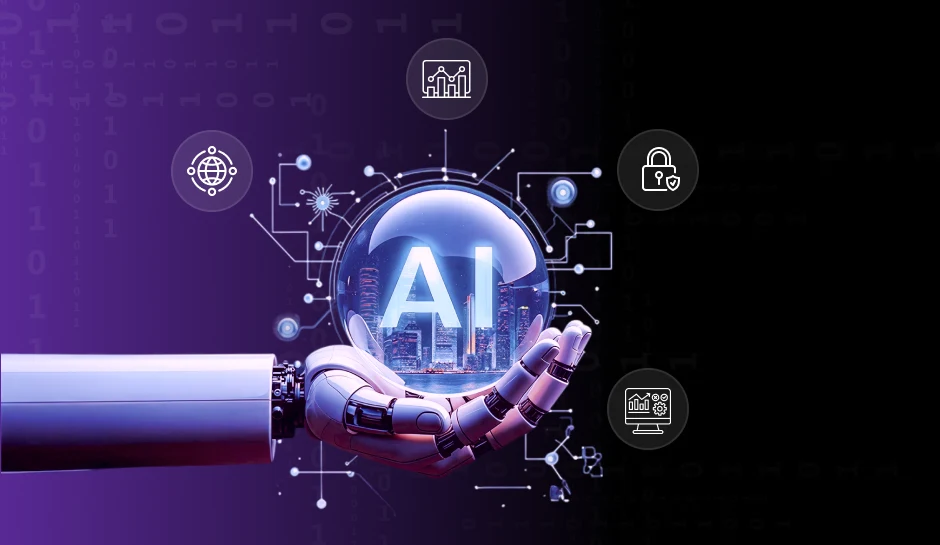
AI-Powered Data Assistants: Transforming How Businesses Analyze Information
AI-powered data assistants are transforming how businesses analyze and leverage data. These intelligent tools automate complex analytics, detect patterns in real-time, and provide actionable insights, helping organizations make data-driven decisions faster. By integrating with ERP, CRM, and cloud platforms, AI-driven assistants eliminate inefficiencies, enhance predictive forecasting, and optimize workflows. Discover how AI is reshaping analytics, driving operational efficiency, and unlocking new business opportunities.
Massive amounts of data move through digital systems every second. Traditional methods struggle to process, analyze, and extract actionable insights efficiently. AI-powered data assistants change this equation completely, automating complex tasks with remarkable speed and accuracy.
Businesses no longer rely on static dashboards or manual reporting. Advanced algorithms handle real-time processing, detect patterns, and provide predictive analytics. This shift redefines workflows, enabling organizations to make faster, data-driven decisions.
Machine learning models continuously improve by adapting to new inputs, enabling smarter automation. AI-driven insights streamline operations across finance, healthcare, marketing, and supply chain management. As adoption grows, AI-powered data assistants reshape the analytical landscape, eliminating inefficiencies and unlocking new opportunities.
AI-Powered Technology – The Core of Modern Analytics
Artificial intelligence drives modern analytics by automating data processing, uncovering patterns, and delivering actionable insights. Organizations use AI-powered data assistants to navigate vast amounts of structured and unstructured data, making sense of complex datasets with speed and accuracy.
Transforming Data Processing with Machine Speed
Traditional data analysis relies on human intervention, manual reporting, and static dashboards. AI-powered systems change the equation. They process terabytes of data in seconds, identifying correlations and trends that manual methods overlook. Businesses gain real-time intelligence, enabling faster and more informed decisions.
- Automated Pattern Identification: AI detects anomalies, seasonality, and predictive markers without human input.
- Real-Time Decision Support: Updates and adjustments occur instantaneously as new data streams in.
- Scalability: AI systems expand analytical capabilities without proportional increases in human effort.
Enhancing Accuracy and Reducing Bias
Human-led analytics often introduce bias through subjective assumptions and limited processing capacity. AI-powered analytics minimize such biases through objective algorithmic evaluation. By training on diverse datasets, machine learning models refine accuracy, adjusting predictions based on real-world feedback.
Consider fraud detection in financial institutions. AI models assess transaction data, flagging anomalies based on learned patterns. Unlike rule-based systems, which depend on predefined conditions, AI refines its detection techniques, adapting to evolving fraud strategies autonomously.
Continuous Learning for Evolving Insights
AI-powered analytics do not remain static. Machine learning continuously refines models, incorporating new data to enhance predictions and business intelligence. This self-improving mechanism ensures that organizations stay ahead of trends rather than reacting to outdated analyses.
- Adaptive Algorithms: Models evolve based on new inputs, improving analytical precision over time.
- Dynamic Market Insights: AI reveals shifting consumer behaviors before traditional reports capture trends.
- Operational Agility: Businesses quickly adjust strategies to match emerging patterns verified by AI analysis.
Seamless Integration with Existing Systems
AI-based analytical tools integrate with enterprise resource planning (ERP) systems, customer relationship management (CRM) software, and cloud-based data lakes. These integrations eliminate silos, providing a unified view of business operations. Decision-makers access consolidated insights without navigating fragmented datasets.
With AI-powered technology at the core of modern analytics, businesses move beyond descriptive reporting into a predictive and prescriptive data-driven future.
Pro Tip- Leverage AI-powered analytics to move beyond historical data—focus on predictive insights and real-time decision-making to stay ahead of market trends and business challenges.
Automated Reporting and Predictive Analytics
Transforming Decision-Making with AI-Driven Insights
Businesses generate vast amounts of data daily, but raw data alone holds little value. AI-powered data assistants streamline reporting by automating data aggregation, analysis, and presentation. This eliminates manual reporting inefficiencies, ensuring that organizations act on real-time insights rather than retrospective summaries.
Incorporating machine learning models enhances automated reporting by identifying anomalies, trends, and correlations. Instead of static reports, businesses receive dynamic dashboards that update as new data flows in. This constant evolution of reporting systems optimizes strategic planning and operational efficiency.
Automated Reporting: Faster, More Accurate Decision Support
Traditional reporting processes involve manual data extraction, formatting, and analysis, often leading to delays and errors. AI-driven reporting eliminates these issues by:
- Automating Data Collection: AI-powered tools connect to multiple data sources, ensuring comprehensive and up-to-date information.
- Standardizing Report Generation: Consistent formatting and automated checks reduce discrepancies, improving reliability.
- Reducing Human Intervention: With predefined workflows, reports are generated and distributed automatically.
- Enhancing Accessibility: AI-based natural language generation (NLG) translates complex data into easy-to-understand narratives.
Organizations that leverage automated reporting minimize the time spent on administrative tasks while improving accuracy and insight depth.
Predictive Analytics: Forecasting Business Outcomes with Precision
AI-powered data assistants do more than summarize past events. By leveraging predictive analytics, businesses anticipate trends, mitigate risks, and seize opportunities. Predictive models analyze historical data, detect patterns, and forecast future scenarios with high accuracy.
Key applications include:
- Sales and Revenue Forecasting: AI algorithms predict future demand based on seasonality, market trends, and customer behavior.
- Customer Churn Prevention: Predictive models identify customers at risk of leaving, enabling targeted retention strategies.
- Supply Chain Optimization: AI-driven analytics improve inventory management by forecasting demand fluctuations.
- Risk Assessment: Financial institutions use predictive models to detect fraudulent activities and assess credit risks.
Real-World Impact of AI in Reporting and Analytics
Data-driven organizations outperform competitors by making proactive, informed decisions. For instance, leading e-commerce platforms use predictive analytics to personalize marketing campaigns, increasing customer engagement and conversion rates. Financial firms apply machine learning to real-time market data, optimizing investment strategies.
With AI-powered data assistants, businesses move beyond descriptive analytics and embrace predictive intelligence. This shift not only improves decision-making but also drives operational efficiency and revenue growth.
Pro Tip- Implement AI-powered predictive analytics to move from reactive decision-making to proactive strategy—anticipating trends gives your business a competitive edge.
Redefining Reporting with Automated Reporting Systems
Streamlining the Presentation of Results
Traditional reporting methods rely on manual data extraction, static templates, and fixed formats. AI-powered automated reporting systems eliminate these inefficiencies, delivering real-time insights in structured and visually engaging formats. Reports that once took hours to compile now generate in seconds, offering up-to-date business intelligence without human intervention.
These systems dynamically update reports based on the latest data, ensuring accuracy and relevance. Decision-makers no longer sift through outdated information; they access evolving insights that reflect business realities. Customization plays a key role-users define parameters, and AI structures reports accordingly, focusing on what’s most relevant.
Multimodal data presentation enhances interpretation. Key metrics appear as interactive charts, while advanced AI-driven natural language generation (NLG) transforms raw figures into narrative summaries. This fusion of structured data and contextual analysis simplifies complex datasets, making them accessible to non-technical stakeholders.
The Role of AI in Generating Dynamic Reports
- Real-Time Analysis: AI-powered reporting tools process live data streams, enabling businesses to make decisions based on the latest information rather than historical figures.
- Predictive Insights: Reports incorporate forecasting models that anticipate future trends, giving businesses a competitive advantage.
- Adaptive Report Structures: Dynamic templates evolve based on user preferences, ensuring each report presents the most relevant data.
- Automated Anomaly Detection: AI identifies deviations in key performance indicators, flagging irregularities that may require immediate action.
- Seamless Integration: AI-powered reporting systems connect with business intelligence platforms, ERP systems, and databases, consolidating information from multiple sources into a single, cohesive view.
Ensuring Data Privacy and Security in AI Systems
Challenges of Data Protection in AI-Powered Analysis
AI systems process massive volumes of data, raising significant challenges for privacy and security. Large-scale data collection increases the risk of breaches, unauthorized access, and misuse. AI models also require extensive training datasets, which often include personally identifiable information (PII) and sensitive business details.
Bias and model inversion attacks present additional concerns. Adversaries can exploit machine learning models to infer private training data, exposing confidential or personal records. Moreover, AI-powered data assistants often integrate with multiple systems, complicating access control and data governance.
Regulatory compliance adds another layer of complexity. Businesses must align AI data handling with frameworks like GDPR, CCPA, and HIPAA. Failure to comply results in financial penalties and reputational damage, making robust security measures non-negotiable.
Strategies for Securing Sensitive Data in AI Platforms
- Differential Privacy: This technique adds statistical noise to datasets, preserving anonymity while maintaining analytical accuracy. Organizations like Apple and Google use this to safeguard user data in AI-driven applications.
- Federated Learning: Instead of centralizing data, federated learning trains AI models across decentralized devices. Models aggregate insights without exposing raw data, minimizing breach risks.
- Zero Trust Architecture: By enforcing strict identity verification, zero trust ensures that no system or user gains access without continuous validation. Enterprises deploying AI-powered platforms integrate this model to mitigate insider threats.
- Audit Trails and Real-Time Monitoring: Continuous logging and anomaly detection help identify suspicious activity before breaches occur. AI-powered security tools analyze behavioral patterns to detect unauthorized access and data exfiltration.
The Cloud Computing Revolution and AI
Leveraging Cloud Infrastructure for AI-Powered Data Analysis
Cloud computing has transformed AI-powered data analysis by providing on-demand access to vast computational resources. With cloud services, organizations can process massive datasets without the limitations of local hardware. Leading providers like AWS, Microsoft Azure, and Google Cloud offer specialized AI and machine learning environments, including pre-built models and scalable storage solutions.
Organizations deploying AI-powered data assistants benefit from cloud-based infrastructure in several ways:
- High-Performance Computing: Cloud environments provide access to powerful GPUs and TPUs optimized for machine learning workloads.
- Data Integration: Seamless connectivity to various data sources, including enterprise databases and third-party APIs.
- Automated Model Training: Cloud AI services streamline machine learning model development with automated tuning and continuous learning.
- Cost Efficiency: Pay-as-you-go pricing structures eliminate the need for expensive on-premises hardware.
Scalability and Accessibility of Cloud-Based AI Assistants
Cloud-hosted AI assistants provide scalable solutions that adapt to changing business needs. Organizations can increase computing power instantly during high-demand periods and scale down when resources are no longer needed. This elasticity ensures cost-effective data analysis without performance bottlenecks.
Remote accessibility is another key advantage. AI-powered data assistants deployed in the cloud allow users to interact with insights from any location, using web-based dashboards and API integrations. This enhances collaboration by providing real-time analytics to different departments across decentralized teams.
With constant updates from cloud AI providers, businesses gain immediate access to the latest AI models and security enhancements, ensuring their data systems remain state-of-the-art. The convergence of cloud computing and AI continues to drive efficiency, scalability, and business intelligence across industries.
Pro Tip- Leverage cloud-based AI solutions to scale data analytics effortlessly—maximize performance, reduce costs, and ensure real-time accessibility from anywhere.
Leveraging ERP and Knowledge Management Systems
Integrating AI into Enterprise Resource Planning
Enterprise Resource Planning (ERP) systems manage critical business functions, from supply chain coordination to financial planning. AI-powered data assistants enhance these systems by introducing automation, predictive insights, and intelligent recommendations. Machine learning algorithms analyze transaction histories to optimize inventory levels, preventing shortages and excess stock.
AI improves demand forecasting by processing historical sales data alongside external factors such as market trends and economic indicators. Automated anomaly detection identifies inconsistencies in financial records by flagging unusual transactions in real-time. Natural language processing (NLP) capabilities enable users to query ERP databases conversationally, reducing the need for manual report generation.
AI-driven process automation streamlines repetitive administrative tasks. Accounts payable and receivable operations benefit from automated invoice matching and fraud detection. Human resource management within ERP systems gains efficiency through AI-driven resume screening and employee performance analytics.
Enhancing Knowledge Management with AI Capabilities
Knowledge Management Systems (KMS) store and distribute critical business information, but AI enhances accessibility and relevance. AI-powered data assistants categorize, index, and retrieve content based on contextual understanding rather than simple keyword matching. This allows employees to quickly find the most relevant documents without sifting through massive data repositories.
Machine learning algorithms assess user behavior to tailor content recommendations. When employees engage with training materials, AI suggests related resources, fostering continuous learning. AI-driven chatbots support internal knowledge sharing by answering common inquiries and providing detailed documentation references.
Natural language processing improves enterprise search functionality. Instead of searching for exact matches, AI interprets intent and fetches the most useful records. Sentiment analysis tools gauge employee feedback from internal communications, assisting management in understanding workforce sentiments.
By integrating AI within ERP and KMS platforms, businesses achieve greater efficiency in decision-making, process automation, and collaborative knowledge sharing.
Pro Tip- Unlock the full potential of AI-powered ERP and Knowledge Management Systems by automating workflows, enhancing search accuracy, and delivering predictive insights for smarter decision-making.
AI-Powered Data Assistants: Driving the Next Business Evolution
AI-powered data assistants have reshaped how businesses interact with data. These systems automate analytics, enhance decision-making, and reduce the time spent on manual processes. Companies integrating AI-driven tools streamline operations, gain predictive capabilities, and stay competitive in evolving markets.
The combination of artificial intelligence, machine learning, and natural language processing delivers real-time insights with unprecedented accuracy. Automated reporting structures eliminate redundant tasks, allowing professionals to focus on strategy rather than data preparation. Predictive analytics models refine forecasting, reducing uncertainty in critical business decisions.
User experience plays a fundamental role in AI adoption. Interactive dashboards, intuitive data visualizations, and seamless integrations transform raw data into actionable knowledge. The balance between advanced analytical power and accessibility ensures that insights remain clear, relevant, and impactful.
Organizations leveraging cloud-based infrastructures and ERP systems unlock greater efficiency. AI-driven assistants seamlessly integrate with enterprise resource planning and knowledge management platforms, centralizing data without compromising security. Encryption protocols and privacy measures safeguard sensitive information while maintaining compliance with evolving regulations.
AI-powered data assistants go beyond automation-they redefine how businesses think about information management. As companies push toward greater digital transformation, these intelligent tools will continue to be at the core of innovation, efficiency, and sustained growth.
Key Takeaways
- AI-powered data assistants process vast datasets in real-time, automating insights and decision-making across industries such as finance, healthcare, and marketing.
- Machine learning models analyze historical data to forecast trends, detect anomalies, and optimize processes like demand forecasting, fraud detection, and customer retention.
- AI-driven tools integrate with ERP, CRM, and cloud platforms, ensuring unified data access, enhanced collaboration, and scalable computing power for smarter business operations.
- Businesses must implement robust data protection strategies, including differential privacy, federated learning, and zero-trust security frameworks, to safeguard sensitive information in AI-driven systems.
Want to learn more about AI-powered data assistants in detail?
Get in touch with our AI data analysts and experts at DiGGrowth. Drop us a line at info@diggrowth.com to get started.
Ready to get started?
Increase your marketing ROI by 30% with custom dashboards & reports that present a clear picture of marketing effectiveness
Start Free Trial
Experience Premium Marketing Analytics At Budget-Friendly Pricing.

Learn how you can accurately measure return on marketing investment.
Additional Resources
How Predictive AI Will Transform Paid Media Strategy in 2026
Paid media isn’t a channel game anymore, it’s...
Read full post postDon’t Let AI Break Your Brand: What Every CMO Should Know
AI isn’t just another marketing tool. It’s changing...
Read full post postFrom Demos to Deployment: Why MCP Is the Foundation of Agentic AI
A quiet revolution is unfolding in AI. And...
Read full post postFAQ's
AI-powered data assistants are intelligent tools that automate data analysis, generate insights, and enhance decision-making by processing vast amounts of structured and unstructured data in real-time.
They eliminate manual data processing, provide predictive analytics, and automate reporting, enabling businesses to make faster, more accurate, and data-driven decisions.
Yes, they seamlessly connect with ERP, CRM, and cloud platforms, ensuring unified access to enterprise data and improving collaboration across departments.
Businesses implement encryption, differential privacy, federated learning, and zero-trust security models to safeguard sensitive information and ensure regulatory compliance.
By analyzing historical data, detecting patterns, and forecasting trends, AI assists in sales projections, risk assessment, customer retention, and supply chain optimization.


